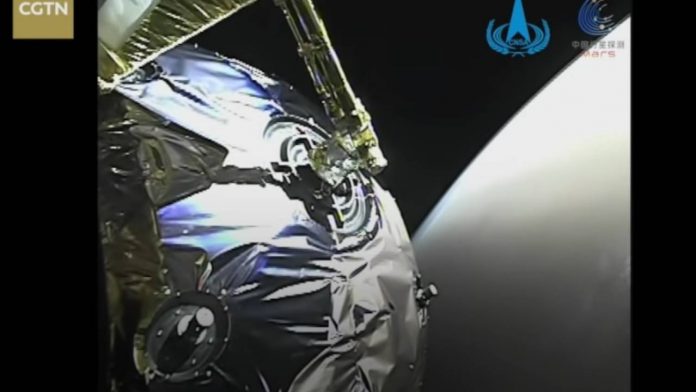China today has shared the first video of Mars recorded by Tianwen-1 after the probe entered orbit, the latest step in Beijing’s ambitious space programme.
Tianwen-1 arrived at Mars on Wednesday (Feb. 10) and fired its engines to allow it to enter orbit around the planet. China has now received and put together a series of images taken during this approach and created two remarkable scenes, seen here in a single video.
One video, taken by Tianwen-1’s small engineering survey sub-system camera for monitoring a solar array, shows Mars entering into frame followed by an incredible view of the edge of Mars’ atmosphere, or “atmospheric limb.”
Craters are also visible on the planet’s surface, while the solar panel appears to oscillate with the spacecraft firing its main engines to decelerate.
A second video is from the point of view of a monitoring camera for Tianwen-1’s tracking antenna, providing similarly amazing footage.
The engineering survey sub-system consists of a number of small monitoring cameras used to monitor processes such as the deployment of solar arrays and other events, according to the China National Space Administration.
The cameras took photos once every three seconds and continuously photographed for around half an hour. The videos have a frame rate of about 10 pictures per second.
Tianwen-1, which means “Questioning the Heavens,” launched on July 23, 2020 and is China’s first independent interplanetary mission. It arrived in orbit around Mars after a 202-day, 295-million-mile (475 million kilometers) journey through deep space. It snapped an image of the Red Planet during its final approach.
The spacecraft consists of both an orbiter and a rover. The landing attempt for the rover is not expected until May or June, giving the orbiter time to image and map out the intended landing site in a region known as Utopia Planitia.
Tianwen-1’s roughly 530-lb. (240 kilograms) solar-powered rover carries science payloads to investigate surface soil characteristics and search for potential water-ice distribution with a ground penetrating radar. The rover also carries a panoramic camera similar to one aboard China’s Yutu 2 rover, which is currently exploring the the far side of Earth’s moon.
The Tianwen-1 orbiter will study the Red Planet’s surface with medium- and high-resolution cameras and a sounding radar, and make other detections with a magnetometer and particle detectors.















